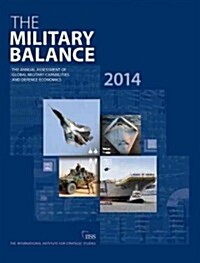
The Military Balance 2014: The annual assessment of global military capabilities and defence economics
- 발행사항
- London : Routledge, 2014
- 형태사항
- 504 p. : ill. ; 25 cm
- ISBN
- 9781857437225
- 청구기호
- 754 MB14
- 서지주기
- Includes index
소장정보
| 위치 | 등록번호 | 청구기호 / 출력 | 상태 | 반납예정일 |
|---|---|---|---|---|
이용 가능 (1) | ||||
| 1자료실 | 00014981 | 대출가능 | - | |
- 등록번호
- 00014981
- 상태/반납예정일
- 대출가능
- -
- 위치/청구기호(출력)
- 1자료실
책 소개
The Military Balance 2014 contains region-by-region analysis of the major military and economic developments affecting defence and security policies and the trade in weapons and other military equipment. Detailed entries describe the military capabilities of 171 countries, displaying key equipment inventories and defence economics. Comprehensive tables detail major training activities, UN and non-UN deployments, and international comparisons of defence expenditure and military personnel.
New Features in The Military Balance 2014:
- New analytical country essays focusing on Algeria, Ethiopia, Brazil, Pakistan, North Korea and China, among others. There are also essays covering conflict analysis and conflict trends, unmanned systems in the land, sea and air domains, and on measuring cyber capabilities.
- Updated graphics feature on comparative defence statistics, with a focus on defence economics, defence industry and major land, sea and air capabilities.
- Updated and expanded national capability summaries.
- An expanded table of military training exercises, arranged by region.
- Tables showing UN and non-UN peacekeeping and security deployments for 2013-14.
- New maps on France’s bases in Africa, the Afghanistan transition process, and peacekeeping operations in Africa.
- Updated Chart of Conflict, with a focus on women in conflict.
This title contains region-by-region analysis of the major military and economic developments affecting defence and security policies and the trade in weapons. Detailed entries describe the military capabilities of 171 countries.
목차
Editor's Introduction. Part 1: Capabilities, Trends and Economics Chapter 1: Conflict Analysis and Conflict Trends Chapter 2: Comparative Defence Statistics Chapter 3: North America Chapter 4: Europe Chapter 5: Russia and Eurasia Chapter 6: Asia Chapter 7: Middle East and North Africa Chapter 8: Latin America and the Caribbean Chapter 9: Sub-Saharan Africa. Chapter 10: Country Comparisons - Commitments, Force Levels and Economics Part 2: Reference Explanatory Notes. Reference.

